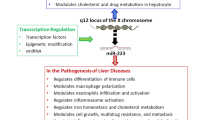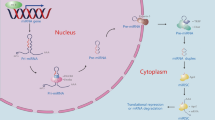Abstract
MicroRNAs are a group of small non-coding RNAs with modulator activity of gene expression. Recent studies have uncovered a profound role of microRNAs in liver diseases. This study aimed to investigate a potential relationship between microRNA-223 (miR-223) expression and hepatic ischemia/reperfusion injury in mice. Quantitative RT-PCR analysis showed that miR-223 expression levels were greatly up-regulated in the livers after 75 min ischemia followed by 120 min reperfusion when compared to sham controls (2.59 ± 0.23 vs. 0.83 ± 0.15; P < 0.01). Correlation analysis also revealed that hepatic miR-223 expression level was significantly positively correlated with serum markers of ischemic injury. By prediction assay of miRNA targets mRNA, acyl-CoA synthetase long-chain family member 3, ephrin A1, and ras homolog gene family member B were predicted to be downstream targets of miR-223. Thus, we conclude that hepatic ischemia/reperfusion injury might be another form of liver disease that is associated with alteration in miR-223 expression.




Similar content being viewed by others
References
Selzner N, Rudiger H, Graf R, Clavien PA. Protective strategies against ischemic injury of the liver. Gastroenterology. 2003;125:917–936. doi:10.1016/S0016-5085(03)01048-5.
Serracino-Inglott F, Habib NA, Mathie RT. Hepatic ischemia-reperfusion injury. Am J Surg. 2001;181:160–166. doi:10.1016/S0002-9610(00)00573-0.
Xu C, Yu C, Li Y. Current studies on therapeutic approaches for ischemia/reperfusion injury in steatotic livers. Hepatol Res. 2008;38:851–859. doi:10.1111/j.1872-034X.2008.00354.x.
Huguet C, Gavelli A, Bona S. Hepatic resection with ischemia of the liver exceeding one hour. J Am Coll Surg. 1994;178:454–458.
Fondevila C, Busuttil RW, Kupiec-Weglinski JW. Hepatic ischemia/reperfusion injury—a fresh look. Exp Mol Pathol. 2003;74:86–93. doi:10.1016/S0014-4800(03)00008-X.
Busuttil RW, Tanaka K. The utility of marginal donors in liver transplantation. Liver Transpl. 2003;9:651–663. doi:10.1053/jlts.2003.50105.
Chan EY, Larson AM, Gernsheimer TB, et al. Recipient and donor factors influence the incidence of graft-vs.-host disease in liver transplant patients. Liver Transpl. 2007;13:516–522. doi:10.1002/lt.21082.
Verran D, Kusyk T, Painter D, et al. Clinical experience gained from the use of 120 steatotic donor livers for orthotopic liver transplantation. Liver Transpl. 2003;9:500–505. doi:10.1053/jlts.2003.50099.
Banga NR, Homer-Vanniasinkam S, Graham A, Al-Mukhtar A, White SA, Prasad KR. Ischaemic preconditioning in transplantation and major resection of the liver. Br J Surg. 2005;92:528–538. doi:10.1002/bjs.5004.
Defamie V, Cursio R, Le Brigand K, et al. Gene expression profiling of human liver transplants identifies an early transcriptional signature associated with initial poor graft function. Am J Transpl. 2008;8:1221–1236. doi:10.1111/j.1600-6143.2008.02249.x.
Borozan I, Chen L, Sun J, et al. Gene expression profiling of acute liver stress during living donor liver transplantation. Am J Transpl. 2006;6:806–824. doi:10.1111/j.1600-6143.2006.01254.x.
Navarro-Sabate A, Peralta C, Calvo MN, et al. Mediators of rat ischemic hepatic preconditioning after cold preservation identified by microarray analysis. Liver Transpl. 2006;12:1615–1625. doi:10.1002/lt.20863.
Bartel DP. MicroRNAs: genomics, biogenesis, mechanism, and function. Cell. 2004;116:281–297. doi:10.1016/S0092-8674(04)00045-5.
Budhu A, Jia HL, Forgues M, et al. Identification of metastasis-related microRNAs in hepatocellular carcinoma. Hepatology. 2008;47:897–907. doi:10.1002/hep.22160.
Murakami Y, Yasuda T, Saigo K, et al. Comprehensive analysis of microRNA expression patterns in hepatocellular carcinoma and non-tumorous tissues. Oncogene. 2006;25:2537–2545. doi:10.1038/sj.onc.1209283.
Shan Y, Zheng J, Lambrecht RW, Bonkovsky HL. Reciprocal effects of micro-RNA-122 on expression of heme oxygenase-1 and hepatitis C virus genes in human hepatocytes. Gastroenterology. 2007;133:1166–1174. doi:10.1053/j.gastro.2007.08.002.
Moffat ID, Boutros PC, Celius T, Linden J, Pohjanvirta R, Okey AB. MicroRNAs in adult rodent liver are refractory to dioxin treatment. Toxicol Sci. 2007;99:470–487. doi:10.1093/toxsci/kfm189.
Girard M, Jacquemin E, Munnich A, Lyonnet S, Henrion-Caude A. miR-122, a paradigm for the role of microRNAs in the liver. J Hepatol. 2008;48:648–656. doi:10.1016/j.jhep.2008.01.019.
Fukao T, Fukuda Y, Kiga K, et al. An evolutionarily conserved mechanism for microRNA-223 expression revealed by microRNA gene profiling. Cell. 2007;129:617–631. doi:10.1016/j.cell.2007.02.048.
Johnnidis JB, Harris MH, Wheeler RT, et al. Regulation of progenitor cell proliferation and granulocyte function by microRNA-223. Nature. 2008;451:1125–1129. doi:10.1038/nature06607.
Wong QW, Lung RW, Law PT, et al. MicroRNA-223 is commonly repressed in hepatocellular carcinoma and potentiates expression of Stathmin1. Gastroenterology. 2008;135:257–269. doi:10.1053/j.gastro.2008.04.003.
Xu C, Zhang X, Yu C, Lu G, Chen S, Xu L, Ding W, Shi Q, Li Y. Proteomic analysis of hepatic ischemia/reperfusion injury and ischemic preconditioning in mice revealed the protective role of ATP5β. Proteomics. 2008. (in press). doi:10.1002/pmic.200800393.
Lewis BP, Shih IH, Jones-Rhoades MW, Bartel DP, Burge CB. Prediction of mammalian microRNA targets. Cell. 2003;115:787–798. doi:10.1016/S0092-8674(03)01018-3.
John B, Enright AJ, Aravin A, Tuschl T, Sander C, Marks DS. Human microRNA targets. PLoS Biol. 2004;2:e363. doi:10.1371/journal.pbio.0020363.
Vascotto C, Cesaratto L, D’Ambrosio C, et al. Proteomic analysis of liver tissues subjected to early ischemia/reperfusion injury during human orthotopic liver transplantation. Proteomics. 2006;6:3455–3465. doi:10.1002/pmic.200500770.
Carthew RW. Gene regulation by microRNAs. Curr Opin Genet Dev. 2006;16:203–208. doi:10.1016/j.gde.2006.02.012.
Fukushima T, Hamada Y, Yamada H, Horii I. Changes of micro-RNA expression in rat liver treated by acetaminophen or carbon tetrachloride—regulating role of micro-RNA for RNA expression. J Toxicol Sci. 2007;32:401–409. doi:10.2131/jts.32.401.
Fujimoto Y, Itabe H, Kinoshita T, et al. Involvement of ACSL in local synthesis of neutral lipids in cytoplasmic lipid droplets in human hepatocyte HuH7. J Lipid Res. 2007;48:1280–1292. doi:10.1194/jlr.M700050-JLR200.
Yamashita T, Ohneda K, Nagano M, et al. Hypoxia-inducible transcription factor-2alpha in endothelial cells regulates tumor neovascularization through activation of ephrin A1. J Biol Chem. 2008;283:18926–18936. doi:10.1074/jbc.M709133200.
Kojima I, Tanaka T, Inagi R, et al. Protective role of hypoxia-inducible factor-2alpha against ischemic damage and oxidative stress in the kidney. J Am Soc Nephrol. 2007;18:1218–1226. doi:10.1681/ASN.2006060639.
Acknowledgments
The authors thank Ms. Qiao-Juan Shi for her help in animal experiments and Drs. Li-Ming Xu and Ding Wei for their assistance in histological analysis. This study was supported by the National Natural Science Foundation of China (No. 30571804).
Author information
Authors and Affiliations
Corresponding author
Additional information
Chao-Hui Yu and Cheng-Fu Xu contributed equally to this work.
Rights and permissions
About this article
Cite this article
Yu, CH., Xu, CF. & Li, YM. Association of MicroRNA-223 Expression with Hepatic Ischemia/Reperfusion Injury in Mice. Dig Dis Sci 54, 2362–2366 (2009). https://doi.org/10.1007/s10620-008-0629-8
Received:
Accepted:
Published:
Issue Date:
DOI: https://doi.org/10.1007/s10620-008-0629-8




